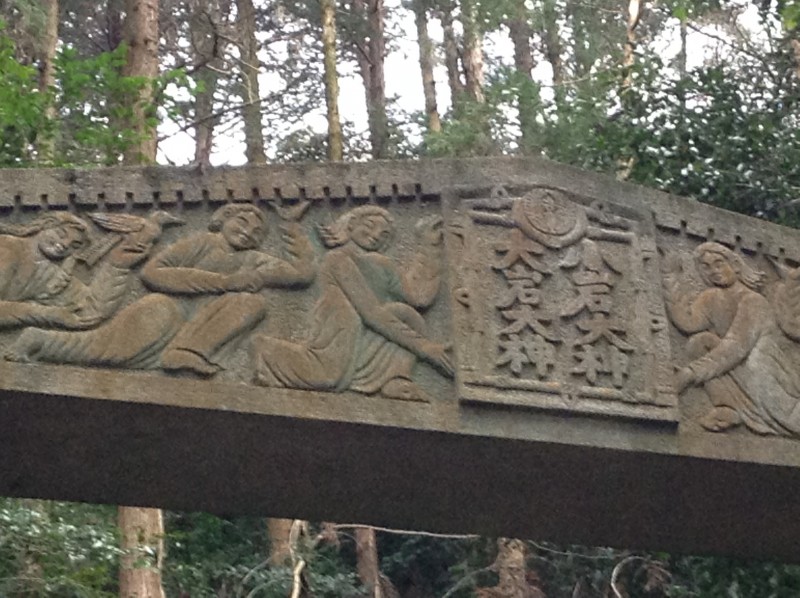
Top part of the Domoto Insho torii bearing the names of two kami Oiwa and Koiwa (in reference to the large and small sacred rocks)
At the Fushimi-ku Fukakasa Ward Office, I enquired whether they knew anything about Oiwa Jinja. The offices are not very far away from Oiwa Hill, some fifteen minutes by car, so I presumed they’d know about such a striking abandoned site in their area. Oddly enough, they hadn’t heard of the shrine and had to get out a map to track down where it was. When they did, I asked about whose responsibility it was, but they told me that I’d have to go to the Land Deeds Office, where I’d need to pay money and wait for some time.
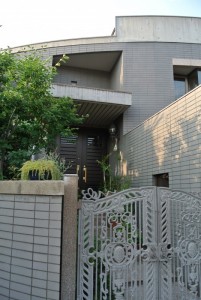
House of the Oiwa Jinja owner
Since the name and address of the legally responsible person was posted at the shrine, there didn’t seem any point. So first I tried to find a phone number, but it turned out the person was not listed. So then I tried tracking down the address, and though I was able to locate the house there was no one at home. Vexing.
One other line of enquiry occurred to me, which was the Domoto Insho museum. Surely they would have information concerning the artist’s torii and their present situation. So I rang them up and asked what would happen to the two torii now that the shrine had been abandoned. They told me that they had no control over that since the torii were owned by the shrine. I wondered if they intended to contact the owner about preserving them, but apparently there were no such plans.
They checked in their files to see what information there was, and although they had pictures of the torii at the time of the donation, they had little else and no staff who knew about them. To my disappointment, the museum proved to know even less than myself. However, a visit to the museum not only revealed that Domoto was extremely close to his mother, but that he lived with her as an adult and never married. The museum he built for his works at the end of his life has a similar design to the torii and a prominent relief of his mother.
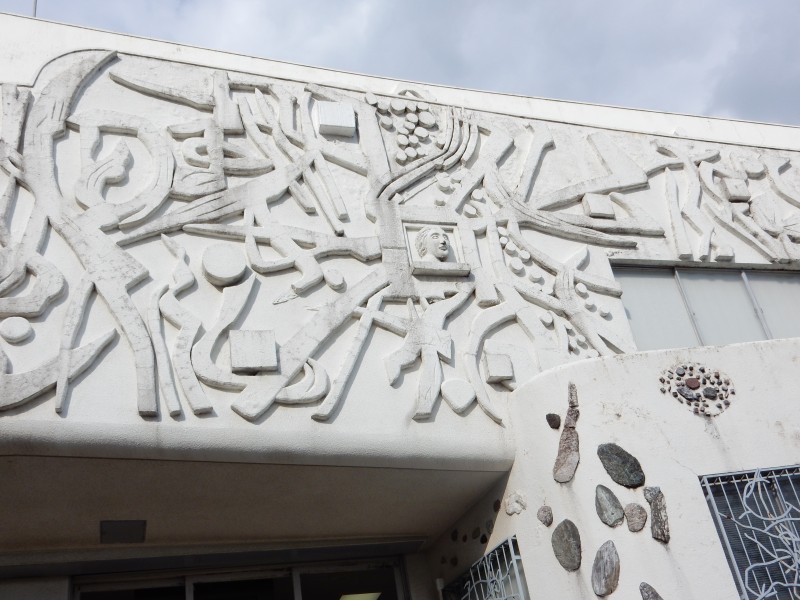
Domoto designed the Domoto Museum himself, with a relief of his mother evident in the middle of the photograph
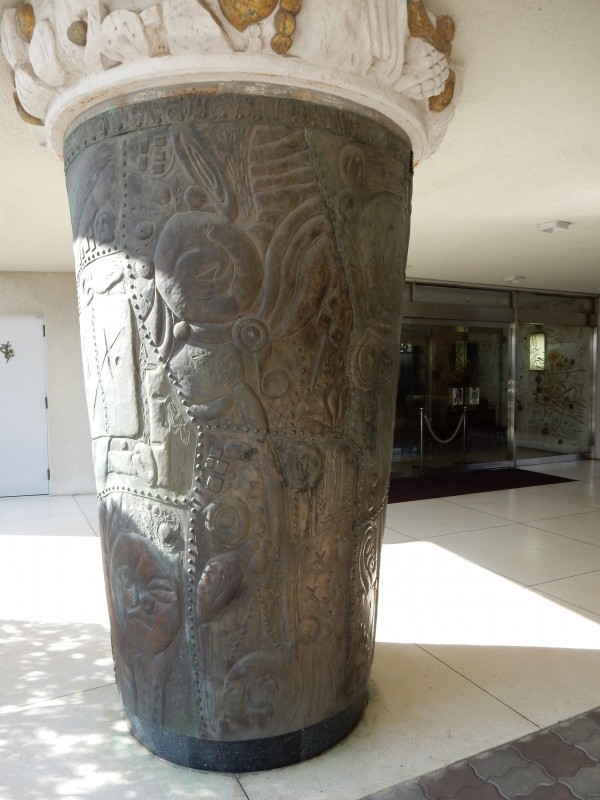
One of the pillars outside the Domoto Museum, with a similar style of design to the torii at Oiwa jinja
I had by now pieced together what I thought may have happened, for my information suggested that one of the torii was donated after Domoto’s mother beseeched the shrine for a cure. The writer of the brochure I’d spoken to suggested the illness was in the upper half of her body, which would be in keeping with the reputation of the shrine for curing lung diseases. It’s possible then that the donation was intended to back up the petition to the kami, or that the mother had been cured and that the torii was given in thanks.

Rabbits and birds, along with human figures, are the main elements in the Domoto motif
The other and grander torii had been donated after the mother’s death, again perhaps in thanks for her long life. On the lower torii were written the dates of a male (70) and a female (95), presumably the ages at which Domoto’s parents had died. The inscription said they were born in the year of the rabbit, which explained the rabbit motif.
Unusually the torii had square legs and the enigmatic design included birds, presumably in reference to tori-i (bird’s roost) and the notion of flight as a vehicle between this world and that of the kami. On the torii was the name of two kami, Oiwa (Big Rock) as well as Koiwa (Little Rock). They were in the same enclosure behind the Worship Hall.
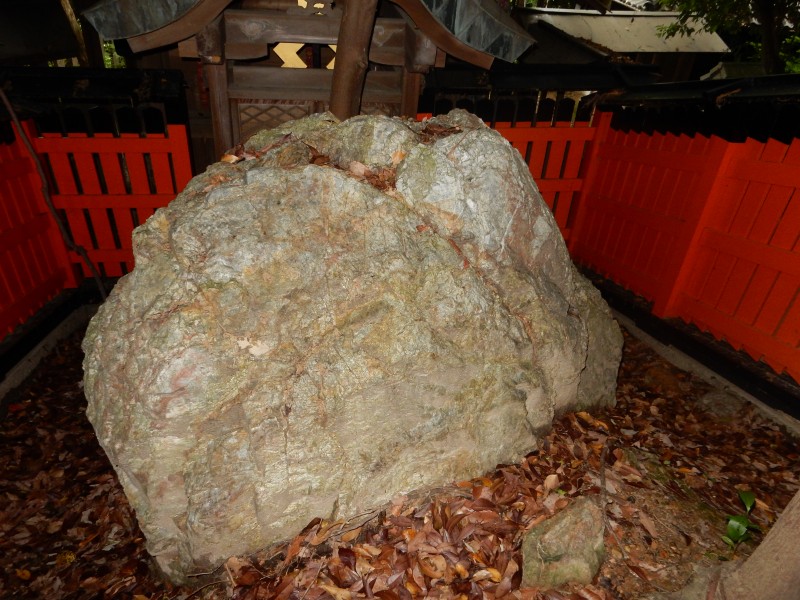
Big Rock and Little Rock, two sacred objects of worship and spirit-bodies for the kami
From my observation there was only one Sanctuary, where unusually alongside the large sacred rock stood another small sacred rock, ‘like a baby’ as my companion put it.
The notion of rocks having babies is an ancient one that goes back into prehistory long before the time of imperial Shinto. Here was yet another indication of an elemental form of Shinto. And the prevalence of otsuka was fascinating, linking the shrine with Fushimi Inari where the stone altars famously cover the hill.
A fanciful notion formed in my mind. Had the Kii clan been part of the incoming Yamato force that marched across the Kii peninsula at the time of Jimmu? And if so, would they not have had Korean origins and be linked with shamanistic rock worship? The route by which some incomers would have arrived, from northern Kyushu and across the Inland Sea, was characterised by a multitude of sacred rocks. And there are several iwakura (sacred rocks) at Fushimi Inari too.
Perhaps then the Kii had settled in the Fukakusa area, and the Fushimi Hill had been their tutelary kami. Perhaps they were ousted by an expanding Hata clan, who claimed the Fushimi Hill as their own with an invented story about a kami appearing there. Perhaps Oiwa Jinja even represented the original form of rock worship in the Kyoto basin, before the appearance of Inari. My fancies were running riot.
I still had two leads to follow up in an attempt to solve the mystery. One was Fushimi Inari, the other the legally responsible owner. I’d had dealings with Fushimi Inari before, and they’d always been most helpful. There is a large team of priests there, some of whom resemble office workers. I’d already learnt that Oiwa Jinja was not a member of Jinja Honcho (Association of Shrines), and neither was Fushimi Inari. It seemed yet another reason to suspect a connection.
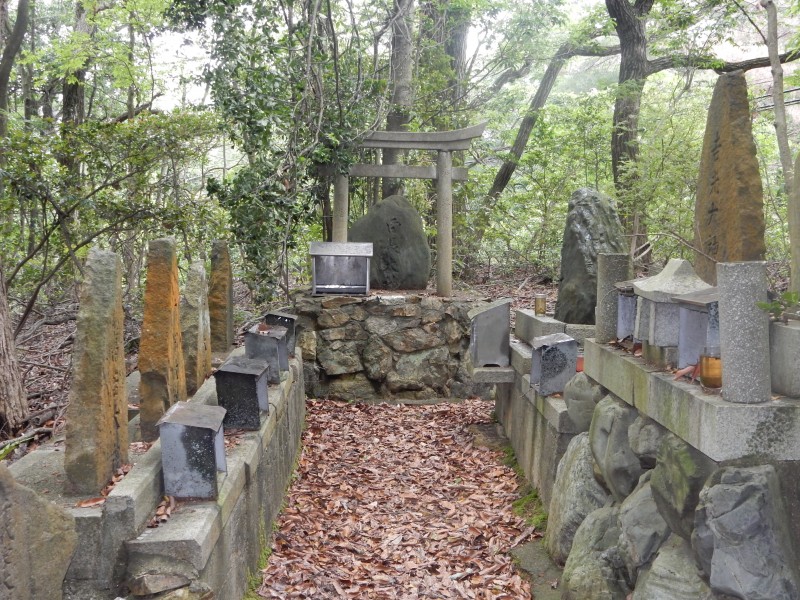
The profusion of ‘otsuka’ stone altars is reminiscent of Fushimi Inari

There’s something about the shrine that lingers in the mind, captured here in a photo by Ken Rodgers showing an eerie black entity in the abandoned compound.

It’s official, you have hooked me and I am as curious as you are as to the origins of this shrine. Any chance of you doing a return trip? If so, let me know. I know someone else that is interested in checking this site out.
Yes I agree a very interesting piece on what look to be a beautiful shrine. Lovely to read what you have been able to find out already but would also like to know how this will evolve and what you are able to unearth of the history of the shrine
So what did you learn from Fushimi Inari Jinja and the Owner?
Thank you for the query. Fusimi Inari said they had nothing to do with Oiwa. The owner is in fact the wife of the man who inherited the shrine. Her son became a priest with Fushimi Inari, but in effect he was just a company employee. For what happened when I called on the owner in her house, please see Part 4. http://www.greenshinto.com/2015/06/30/the-mystery-of-oiwa-pt-4/
I would love to know more about that mysterious black entity. Its shape resembles a monkey.
I think you’re referring to the komainu guarding the entrance to the Haiden, and yes, it does look like a monkey (usually monkeys are seen as the animal messenger of Sanno, the Mt Hiei deity).
But isn’t he refering to the Black thing on the bottom/mid left corner?. The koimanu is the Grey Stone on the top right, isn’t It?
Are you asking about the bottom picture by Ken Rodgers? Mid left is a black mysterious object, and komainu is mid-right…
Tamamo no mae location.. i think.. she was cursed by spell and her spirit locked somewhere, so her body was there with evil spirit. She became vampire, she is there somewhere in that location.